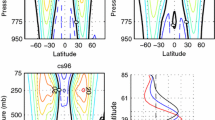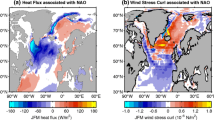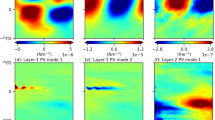Abstract
The interplay between the North Atlantic Oscillation (NAO) and the large scale ocean circulation is inspected in a twentieth century simulation conducted with a state-of-the-art coupled general circulation model. Significant lead–lag covariance between oceanic and tropospheric variables suggests that the system supports a damped oscillatory mode involving an active ocean–atmosphere coupling, with a typical NAO-like space structure and a 5 years timescale, qualitatively consistent with a mid-latitude delayed oscillator paradigm. The two essential processes governing the oscillation are (1) a negative feedback between ocean gyre circulation and the high latitude SST meridional gradient and (2) a positive feedback between SST and the NAO. The atmospheric NAO pattern appears to have a weaker projection on the ocean meridional overturning, compared to the gyre circulation, which leads to a secondary role for the thermohaline circulation in driving the meridional heat transport, and thus the oscillatory mode.
















Similar content being viewed by others
References
Anderson D, Bryan K, Gill A, Pacanowski R (1979) The transient response of the North Atlantic: some model studies. J Geophys Res 84:4795–4815
Baringer M, Larsen J (2001) Sixteen years of florida current transport at 27N. Geophys Res Lett 28:3179–3182
Bellucci A, Richards KJ (2006) Effects of NAO variability on the North Atlantic Ocean circulation. Geophys Res Lett 33:L02612. doi:10.1029/2005GL024890
Blackman R, Tukey JW (1958) The measurement of power spectra from the point of view of communication engineering. Dover, Mineola
Bretherton C, Battisti D (2000) An interpretation of the results from atmospheric general circulation models forced by the time history of the observed sea surface temperature distribution. Geophys Res Lett 27:767–770
Cayan D (1992) Latent and sensible heat flux anomalies over the Northern oceans: driving the sea surface temperature. J Phys Oceanogr 22:859–881
Czaja A, Frankignoul C (2002) Observed impact of Atlantic SST anomalies on the North Atlantic Oscillation. J Clim 15:606–623
Czaja A, Marshall J (2001) Observations of atmosphere ocean coupling in the North Atlantic. J R Meteor Soc 127:1893–1916
D’Andrea F, Czaja A, Marshall J (2005) Impact of anomalous ocean heat transport on the North Atlantic Oscillation. J Clim 18:4955–4969
Deser C, Blackmon R (1993) Surface climate variations over the North Atlantic during winter: 1900–1989. J Clim 10:393–408
Eden C, Greatbatch R (2003) A damped decadal oscillation in the North Atlantic climate system. J Clim 16:4043–4060
Eden C, Willebrandt J (2001) Mechanisms of interannual to decadal variability in the North Atlantic circulation. J Clim 14:2266–2280
Feldstein SB (2000) The timescale, power spectra, and climate noise properties of teleconnection patterns. J Clim 13:4430–4440
Ferreira D, Frankignoul C (2005) The transient atmospheric to midlatitude SST anomalies. J Clim 18:1049–1067
Fichefet T, Morales-Maqueda MA (1999) Modelling the influence of snow accumulation and snow-ice formation on the seasonal cycle of the Antarctic sea-ice cover. Clim Dyn 15:251–268
Frankignoul C, Hasselmann K (1977) Stochastic climate models, part II: applications to sea-surface temperature variability and thermocline variability. Tellus 29:289–305
Frankignoul C, Czaja A, L’Heveder B (1998) Air-sea feedback in the North Atlantic and surface boundary conditions for ocean models. J Clim 11:2310–2324
Frankignoul C, Kestenare E, Sennéchael N, de Coëtlogon G, D’Andrea F (2000) On decadal-scale ocean-atmosphere interactions in the extended ECHAM1/LSG climate simulation. Clim Dyn 16:333–354
Grötzner A, Latif M, Barnett T (1998) A decadal climate cycle in the North Atlantic ocean as simulated by the ECHO coupled GCM. J Clim 11:831-847
Gualdi S, Navarra A, Guilyardi E, Delecluse P (2003a) Assessment of the tropical Indo-Pacific climate in the SINTEX CGCM. Ann Geophys 46:1–26
Gualdi S, Guilyardi E, Navarra A, Masina S, Delecluse P (2003b) The interannual variability in the tropical Indian Ocean as simulated by a CGCM. Clim Dyn 20:567–582
Gualdi S, Scoccimarro E, Navarra A (2007) Changes in tropical cyclone activity due to global warming: results from a high-resolution coupled general circulation model. J Clim (in press)
Guilyardi E, Delecluse P, Gualdi S, Navarra A (2003) Mechanisms for ENSO phase change in a coupled GCM. Clim Dyn 16:1141–1158
Hurrell J, Kushnir Y, Ottersen G, Visbeck M (2003) An overview of the North Atlantic Oscillation. In: Hurrell J , Kushnir J, Ottersen G, Visbeck M (eds) The North Atlantic Oscillation: climatic significance and environmental impact. American Geophysical Union, Washington DC
Kaplan A, Kushnir Y, Cane M, Blumenthal B (1997) Reduced space optimal analysis for historical datasets:136 years of Atlantic sea surface temperatures. J Geophys Res 102:27835–27860
Killworth P, Chelton D, de Szoeke R (1997) The speed of observed and theoretical long extratropical planetary waves. J Phys Oceanogr 27:1946–1966
Kuhlbrodt T, Griesel A, Montoya M, Levermann A, Hofmann M, Rahmstorf S (2007) On the driving processes of the Atlantic meridional overturning circulation. Rev Geophys 45:1–32
Latif M, Barnett T (1994) Causes of decadal variability over the North Pacific and North America. Science 266:634–637
Latif M, Barnett T (1996) Decadal climate variability over the North Pacific and North America: dynamics and predictability. J Clim 9:2407–2423
Luo J, Masson S, Behera S, Delecluse P, Gualdi S, Navarra A, Yamagata T (2003) South pacific origin of the decadal ENSO-like variation as simulated by a coupled GCM. Geophys Res Lett 30, 2250. doi:10.1029/2003GL018649
Madden R (1981) A quantitative approach to long range prediction. J Geophys Res 86:9817–9825
Marotzke J, Klinger B (2000) A study of the interaction of the North Atlantic Oscillation with the ocean circulation. J Phys Oceanogr 30:955–970
Marshall J, Johnson H, Goodman J (2001) A study of the interaction of the North Atlantic Oscillation with the ocean circulation. J Clim 14:1399–1421
Neelin JD, Weng W (1999) Analytical prototypes for ocean-atmosphere interaction at midlatitudes. Part I: coupled feedbacks as a sea surface temperature dependent stochastic process. J Clim 12:697–721
Peng S, Whitaker JS (1999) Mechanisms determining the atmospheric response to midlatitude SST anomalies. J Clim 12:1393–1408
Peng S, Robinson W, Li S (2002) North Atlantic SST forcing of the NAO and relationships with intrinsic hemispheric variability. Geophys Res Lett 29:1276. doi:10.1029/2001GL014043
Peng S, Robinson W, Li S (2003) Mechanisms for the NAO responses to the North Atlantic SST tripole. J Clim 16:1987–2004
Rodwell M, Rowell D, Folland C (1999) Oceanic forcing of the wintertime North Atlantic Oscillation and European climate. Nature 398:320–323
Saravanan R, McWilliams J (1998) Advective ocean-atmosphere interaction: an analytical stochastic model with implications for decadal variability. J Clim 11:165–188
Schneider E, Fan M (2007) Weather noise forcing of surface climate variability. J Atm Sci 64:3265–3280
Schott F, Lee T, Zantopp R (1988) Variability of structure and transport of the florida current in the period range of days to seasonal. J Phys Oceanogr 18:1209–1230
Stephenson D, Pavan V, Collins M, Junge M, Quadrelli R (2006) North Atlantic Oscillation response to transient greenhouse gas forcing and the impact on European winter climate: a CMIP2 multi-model assessment. Clim Dyn 27:401–420. doi:10.1007/s00382-006-0140-x
Storch HV, Zwiers FW (1999) Statistical analysis in climate research. Cambridge University Press, United Kingdom
Sutton RT, Allen MR (1997) Decadal predictability of North Atlantic sea surface temperature and climate. Nature 388:563–567
Thompson D, Lee S, Baldwin M (2003) Atmospheric processes governing the Northern Hemisphere Annular Mode/North Atlantic Oscillation. In: Hurrell J, Kushnir J, Ottersen G, Visbeck M (eds) The North Atlantic Oscillation: climatic significance and environmental impact. American Geophysical Union, Washington DC
Visbeck M, Chassignet E, Curry RG, Delworth T, Dickson R, Krahmann G (2003) The ocean’s response to North Atlantic Oscillation. In: Hurrell J, Kushnir J, Ottersen G, Visbeck M (eds) The North Atlantic Oscillation: climatic significance and environmental impact. American Geophysical Union, Washington DC
Watanabe M, Kimoto M (2000) On the persistence of decadal SST anomalies in the North Atlantic. J Clim 13:3017–3028
Wunsch C (1999) The interpretation of short climate records, with comments on the North Atlantic Oscillation and Southern Oscillations. Bull Am Meteor Soc 80:245–255
Zorita E, Frankignoul C (1997) Modes of North Atlantic decadal variability in the ECHAM1/LSG coupled atmosphere-ocean general circulation model. J Clim 10:183:200
Acknowledgements
The authors wish to thank Riccardo Farneti and Annalisa Cherchi for stimulating discussions and precious support. Comments from three reviewers considerably improved the original manuscript. This work was supported by the Centro Euro-Mediterraneo per i Cambiamenti Climatici (CMCC) Project and the European Community ENSEMBLES Project (Contract GOCECT-2003-505539).
Author information
Authors and Affiliations
Corresponding author
Rights and permissions
About this article
Cite this article
Bellucci, A., Gualdi, S., Scoccimarro, E. et al. NAO–ocean circulation interactions in a coupled general circulation model. Clim Dyn 31, 759–777 (2008). https://doi.org/10.1007/s00382-008-0408-4
Received:
Accepted:
Published:
Issue Date:
DOI: https://doi.org/10.1007/s00382-008-0408-4




